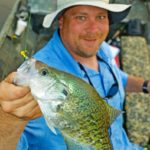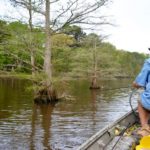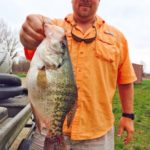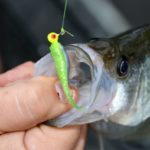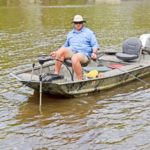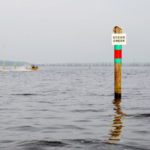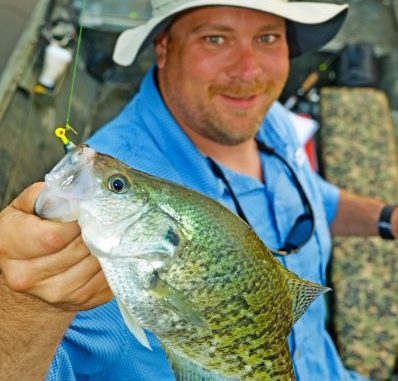
Lake D’Arbonne is known for producing boat loads of crappie for anglers in the know. This Sterlington Middle School coach provides pointers that will have you catching perch in no time.
John Odom is a big guy — 6-foot, 4-inches and 290 pounds “after a recent diet,” he informed me.
On the telephone he sounded like a pretty standard-sized guy, but with his powerful, sloping shoulders and fluidly graceful movements he looked like a football player, which is what he was.
Now he is a football coach and history teacher at Sterlington Middle School, located north of his West Monroe home.
When he isn’t coaching or teaching, he’s fishing or hunting, which is how our paths crossed.
Odom had just pegged a 3.15-ounce white crappie in the No. 9 slot of the Louisiana State Fish Records. One look at the sway-bellied sow in his hands convinced me I had to call him.
His “aw shucks” attitude immediately appealed to me.
“I’m really a numbers kind of guy,” Odom said. “I just happened to be in the right place at the right time.”
He doesn’t own a high-powered bass boat or a boat custom built for crappie fishing. His tackle is all store-bought and relatively simple.
Odom seemed unassuming and friendly, eager to share his knowledge, explaining that everything he knows he learned from other people. He seemed to just be an average Joe who worked hard and caught a lot of fish in his off time.
Just the kind of guy I wanted to fish with.
His record crappie came from Poverty Point Lake, but he said over the phone that he would rather take me to Lake D’Arbonne, his favorite white perch (a term he used more often than crappie) hole.
“It has more options, and fishing pressure is more spread out,” Odom explained.
D’Arbonne measures 15,250 acres, compared to 4,000 for Poverty Point.
When we got to the Stowe Creek Public Boat Launch on Highway 15 at daylight, a steady stream of boats was launching. Most anglers were old-timers wearing bib overalls, and most were fishing solo.
He started off fishing tight to the bank in a foot of water. It was early April and he was looking for males that had built spawning beds in shallow water.
Timing-wise, female crappies had just begun entering the nesting areas.
“Crappie spawn about two weeks later in Lake D’Arbonne than in other waters nearby,” Odom said.
He started with a Bobby Garland Baby Shad in bayou booger color on a chartreuse 1/16-ounce jighead. He twitched and teased the tight-lined jig with 3 feet of line out on his 11-foot graphite pole.
He carried two jig poles in his boat. One was rigged with a small spinning reel, and the other had a Mr. Crappie Solo reel. Neither reel was used for casting, being used simply for line storage.
For casting, he uses a closed face spin-cast reel slung on a 4½-foot ultralight rod, but the early tools of choice this day were the jig poles.
Odom noted that he isn’t particular about his line brand, but he prefers high-visibility golden or chartreuse lines in 6- or 8-pound test because being able to see the least twitch in the line is important when he fishing without a cork.
The big guy saw a tiny swirl in the water next to a twig, dropped his jig into it and pulled out a nice, fat female. He was openly pleased with the fish.
“That’s the first female I’ve taken from shallow water this year,” Odom said. “All the shallow-water fish have been males. It means that the spawn hasn’t fully started yet.”
Odom explained that white perch overwinter in the depths of Lake D’Arbonne, in water more than 20 feet deep.
Males enter shallow water first, sometime in March, where they will build spawning nests.
Two weeks or so later, females follow them for spawning.
When the females join the males in the shallows, both sexes can be caught, although more females will probably bite.
Once females become active, Odom concentrates on flats in water 5 to 10 feet deep. Females, he said, only come into the shallows to spawn, which takes a matter of minutes.
Odom described “flats” as waters between the deeper channels or boat lanes and the bank of the lake. Oftentimes, a good flat is a couple hundred yards from the bank.
That seemed like a lot of territory, so how does he find fish?
“I use my depth sounder to look for the depth to fish at,” Odom explained. “I will start deep: 12 to 15 feet. As it warms, I gradually fish shallower until I am in 5 feet of water during the late spawn.
“Trial and error will teach you. Of course, if you see a concentration of boats, that is a good spot. Some spots are definitely better than others. Often times the best spots on the flats are immediately out from a spot in the shallows that was good fishing.”
After picking up another couple of fish in the shallows, Odom moved his boat to a favorite 6-foot-deep flat in Bear Creek.
On the flat, he became a two-gun man, using a jig pole in each hand.
The second pole he rigged with a blue thunder Baby Shad. He noted that he will also use the colors Cajun cricket and lights out.
He tipped one jig with a live shiner and the other with a chartreuse Berkley PowerBait Crappie Nibble.
“Ninety percent of the time on the flats, my jig is tipped with a Crappie Nibble,” Odom said. “In the shallows, where hang-ups are common, they get knocked off the hook too easily.”
He was used 1/16-ounce jigheads on the flats, but Odom said that probably 10 percent of the time, when it is very windy or when he fishes deeper water he switched to 1/8-ounce jigs.
And he is particular about jighead color, almost always using chartreuse heads. If not chartreuse, he uses red.
His technique for fishing the flats was slow and methodical.
Perched on his pedestal bow seat with a pole held in each hand, he moved the boat very slowly by bumping the trolling motor’s foot control every once in a while.
“Always troll into the wind,” Odom advised. “If you troll with the wind, the boat moves too fast and the baits don’t get to the right depth.”
He demonstrated. Sure enough: When fishing with the wind, the line descended straight down from his rod tip, while fishing against the wind resulted in the line angling sharply into the water.
He let out enough line from a reel to either fish mid-depth in the water column or just off the bottom. He definitely avoided bottom bouncing, however.
He began catching fish regularly on both the jig with the Nibbles and the one with the shiner.
“By May, the fish move to 15-foot depths,” he explained, as he unhooked a big white slab. “I fish the same way — with two rods, but deeper. I do this all the way through June. By July and August, the white perch go even deeper, and they get tough to catch, so I shift to bream and bass fishing.
“Then football season starts (remember, he’s a coach), and my free time in the winter is given over to hunting.”
Getting tired of this gig, Odom demonstrated another white perch tactic.
He moved the boat to the head of Bear Creek and probed individual cypress trees standing in 3 to 4 feet of water.
“This is very productive during spawning season,” Odom said. “If they are there, you will catch them right away.”
They weren’t there this day.
The next tactic was to put the jig poles up and grab his ultra-light spinning rod rigged with a jig under a small cork. With this, he probed the shallow edges of grass beds near shore for male white perch on their nests.
He was able to lay the jig poles aside because he didn’t have to deal with probing his bait into tree limbs, and the spinning rod allowed him to stay out of the shallows with his boat.
Odom moved from Bear Creek to the lower part of the main lake. There, in more-open and slightly deeper water, he stuck with his ultra-light spinning rod and tossed a Road Runner, again rigged with a Baby Shad.
“These are really effective in open areas where there a few hang-ups,” Odom rumbled. “You can come off the bank in the shallows or in 10- to 15-foot-deep water, (and) you simply count the lure down to the depth you want and slow-roll retrieve it.
“Bream will hit them; bass will hit them; white perch really love them.”
Here, he caught the biggest crappie of the day: heavily pigmented, nest-guarding males big enough to have shoulders on them.
“I encourage experimenting,” Odom said in the understatement of the year.
When the wind really started honking in mid-morning, he just added a tiny split shot to the line 2 inches above the jighead to keep in touch with his bait.
He wouldn’t quit when other anglers were off the water by noon.
He was indefatigable.
“Remember,” a big grin washed over this face, “these are my favorite fish to eat.”
